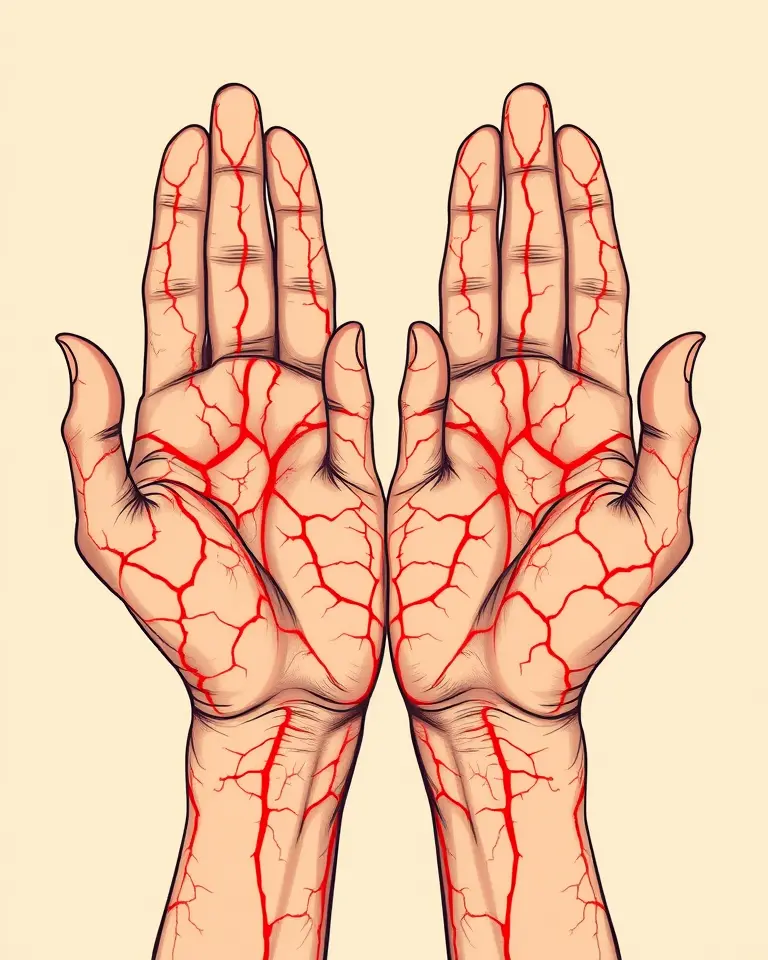It’s a familiar scenario for many fitness enthusiasts: you’re pushing hard during a workout, feeling the burn, and then suddenly, your hands start to tingle or go numb. Or perhaps you notice your knuckles are turning white as you grip the weights. These seemingly minor hand issues can be significant indicators that your exercise routine might need some adjustments. Ignoring these signs could lead to discomfort, reduced performance, and even potential injuries.
The Grip Connection: How Your Hands Signal Workout Problems
Your hands play a vital role in many exercises, from lifting weights to performing bodyweight movements. A proper grip is essential for maintaining form, engaging the correct muscles, and preventing injuries. When your grip is off, it can manifest in various ways, often felt in your hands.
White Knuckles and Restricted Blood Flow
One of the most telling signs of an improper grip is white knuckles. This occurs when you are gripping too tightly, restricting blood flow to your hands. This excessive tension can lead to muscle fatigue and reduce the effectiveness of your workout. It’s a clear signal to reassess how you’re holding the weights or equipment. If you’re experiencing white knuckles, you’re likely overcompensating, possibly trying to lift weights that are too heavy, or using the wrong technique.
Excessive Pain and Wrist Strain
If you experience excessive pain in your hands or wrists during or after a workout, it’s another indication that something is amiss. While some muscle soreness is normal, sharp or persistent pain is not. This kind of discomfort can be a result of gripping too hard, poor wrist alignment, or using equipment improperly. It’s your body’s way of telling you that there’s undue stress on the joints and muscles, and you should take heed.
Muscle Fatigue and Overworked Arms
Do you find that your arms and wrists fatigue quickly during simple exercises? This could be another sign of poor grip. When your grip is inefficient, other muscles may compensate, leading to rapid fatigue and increased risk of injury. If you are noticing this, re-evaluate your grip technique and ensure you’re not relying too much on your arms.
Beyond Grip: Other Hand Signals to Watch For
While grip-related issues are common, other hand symptoms can also indicate problems with your exercise routine.
Numbness and Tingling: A Sign of Nerve Issues
Numbness and tingling in your hands during or after exercise can be alarming. This sensation is often related to nerve compression or irritation. The median nerve, which passes through the carpal tunnel in the wrist, is particularly susceptible to compression. This compression can result in carpal tunnel syndrome, which causes numbness, tingling, and pain in the thumb, index, middle, and part of the ring finger. Other nerves like the ulnar and radial nerves can also be affected, resulting in similar sensations.
The Role of Clenching Fists
According to experts, clenching your fists too tightly during workouts can also worsen numbness or tingling. This action restricts blood flow and can put undue pressure on nerves. It is often observed when people are stressed or rushing through their exercises. Instead, try to maintain a relaxed grip, allowing for better blood circulation and less strain on the nerves.
Overtraining: When Too Much Exercise Hurts
Overtraining occurs when you exercise too intensely or frequently without allowing your body adequate recovery time. This can manifest in many ways, including hand issues. Other signs of overtraining may include:
- Decreased performance: A plateau or decline in your workout progress despite increased effort.
- Excessive fatigue: Feeling unusually tired or lacking energy, even after rest.
- Recurring injuries: Experiencing frequent muscle strains, tendonitis, or joint pain.
- Poor sleep: Difficulty falling asleep, staying asleep, or waking up feeling unrested.
- Mood changes: Increased irritability, anxiety, or depression.
If you’re experiencing these symptoms, it may be necessary to scale back your training and prioritize recovery.
What Can You Do?
If you’re experiencing any of these hand-related symptoms, it’s time to take action. Here are a few things you can do:
Evaluate Your Grip Technique
Pay close attention to how you grip weights and equipment during your workouts. Avoid clenching tightly. Instead, maintain a firm but relaxed grip. Consider using wrist straps or gloves to help improve your hold without over-gripping. It is vital to ensure that the correct muscles are doing the work.
Incorporate Nerve Flossing Exercises
Nerve gliding or flossing exercises can help relieve pressure on compressed nerves. These exercises involve gentle movements that allow the nerves to move freely through the body. Some common nerve flossing exercises include:
- Median Nerve Glide: Make a fist, then extend your fingers, keeping your thumb close. Bend your hand backward towards your arm and then extend your thumb away from your fingers. Turn your forearm so your hand is palm up, and use your other hand to pull your thumb back.
- Ulnar Nerve Glide: Start with your arm straight, palm down, with your thumb and index finger touching. Bend your elbow, bringing your hand towards your face in a circling motion.
- Radial Nerve Glide: Extend your arm forward, palm up, and then slowly straighten your arm, keeping the wrist extended. You can tilt your head towards your shoulder on the same side to increase the stretch.
These exercises should be performed gently and stopped if they cause pain.
Rest and Recovery
Allow your body sufficient rest between workouts. This allows your muscles and nerves to recover and repair themselves, preventing overtraining and injuries. Incorporate rest days into your routine and ensure you’re getting enough sleep, which is vital for muscle recovery.
Adjust Your Routine
Vary your exercises to avoid overworking specific muscles and joints. If you are experiencing pain or discomfort, it is important to consult with a healthcare professional or a certified trainer to develop a workout plan that suits your needs and abilities. This may include incorporating exercises that strengthen your grip and forearm muscles. Some exercises to improve your grip are:
- Tennis ball squeeze: Squeeze a tennis ball or stress ball in your hand for a few seconds and release. Repeat several times.
- Towel wringing: Twist a wet towel in opposite directions to wring out the water.
- Reverse wrist curls: Use light weights to perform wrist curls with your palms down.
Seek Professional Advice
If your symptoms are persistent or severe, it’s important to consult with a medical professional. They can help diagnose the underlying cause of your pain, numbness, or tingling, and recommend appropriate treatment. This may include physical therapy, medication, or other interventions.
A Balanced Approach to Fitness
Ultimately, listening to your body is paramount. The signs your hands give you during exercise can be valuable indicators of the state of your routine. It’s not about pushing harder, but about training smarter. By paying attention to your body’s signals, especially those coming from your hands, adjusting your grip, incorporating recovery, and knowing when to seek professional help, you can create a fitness routine that is both effective and safe. Remember, fitness is a journey, not a sprint, so taking care of your body is crucial for long-term health and well-being.







